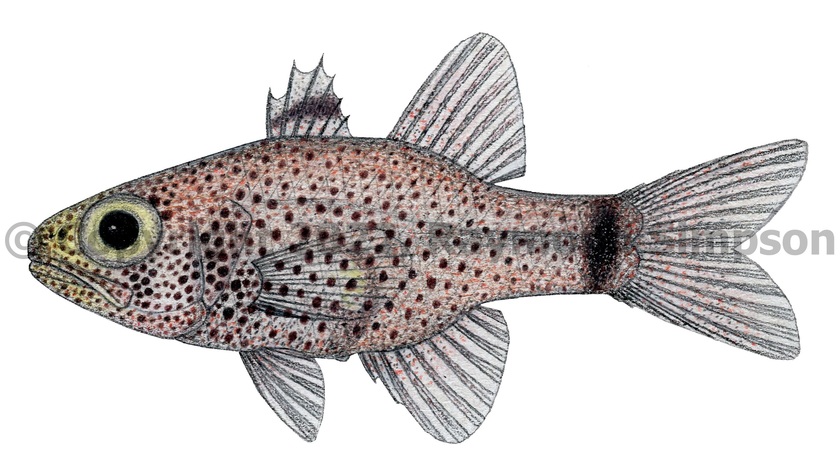
Common Name
Dusky Cardinalfish
Year Described
Poey, 1860
Identification
Dorsal Fin: VI, I-9
Anal Fin: II, 8
Pelvic Fin: I, 5
Pectoral Fin: 11-12
Gill Rakers: 11-13 lower (first arch)
Vertebrae: 10 precaudal, 14-15 caudal
A small fish with a fairly robust and moderately compressed body. Eye is large and the snout short. Mouth is fairly large and oblique, with the lower jaw slightly protruding. Jaws with bands of villiform teeth with an occasional larger tooth mixed in. Vomer and palatine with villiform teeth. Preopercular edge with a finely serrate margin. Preopercular flap extends close to opercular margin. There are two dorsal fins. The caudal fin is forked. Body scales ctenoid. There are 5-6 predorsal scales and 16 circum-peduncular scales.
Color
Body translucent pink to pale brown with pearly silvery markings. A spot on each scale forms a network of spots on the body. Stellate melanophores on head. A medium-sized to large oval blotch on the caudal peduncle. Fins clear with a faint sprinkling of melanophores on the base of the fins. Eye silver with a dark bar under it.
Size
Maximum size to 76mm TL.
Habitat
Inhabits coral reefs inside structure.
Range
S. Florida to Brazil, including the Gulf of Mexico and the Caribbean. Also Bermuda.
References
Gon, O. 2002. Apogonidae (pp 1386-1391). In: Carpenter. 2002. The living marine resources of the Western Central Atlantic. Vol. 3: Bony fishes part 2 (Opistognathidae to Molidae), sea turtles and sea mammals. FAO Species Identification Guides for Fisheries Purposes. American Society of Ichthyologists and Herpetologists Special Publication No. 5.
McEachran, J.D. & J.D. Fechhelm. 2005. Fishes of the Gulf of Mexico. Volume 2: Scorpaeniformes to Tetraodontiformes. University of Texas Press, Austin. i-viii +1-1004.